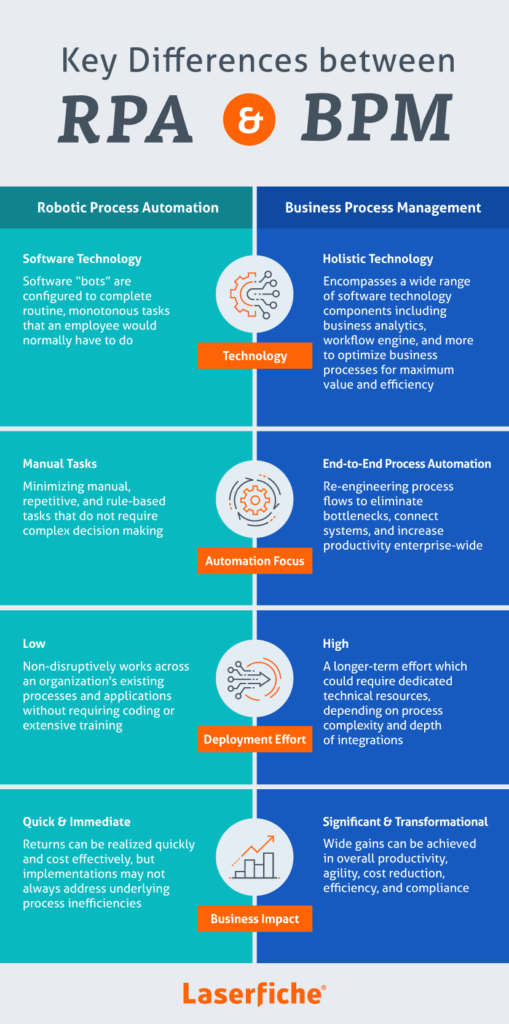What is the difference between RPA and BPM?
For many organizations, achieving digital transformation is not an overnight process. Fortunately, there are tools to help organizations make significant advances and be better positioned to reap the rewards of a digital workplace. For years, business process management (BPM) technologies have been a core part of many organizations’ digital transformation strategies. As new innovations in the industry emerge, organizations are finding even more opportunities to become digitally adept. Robotic Process Automation (RPA) has been gaining popularity as the latest automation tool to drive workplace efficiency and productivity – but how is it different from traditional business process management approaches?
While distinct in their own right, RPA and BPM are complementary to each other and, when deployed together, provide a powerful platform to enable digital transformation organization-wide.
Key Differences between RPA and BPM
As RPA becomes more of a mainstream solution, how does it fit within the context of existing BPM technologies? Let’s investigate the key differences between RPA and BPM.

Let’s take a step back to outline the definitions of RPA and BPM as distinct methodologies.
Definition of RPA
Robotic Process Automation is a software technology that enables employees to better focus on high priority tasks by pushing routine, monotonous tasks to software “robots” to complete. These robots work directly across application user interfaces, automatically inputting data and triggering actions across multiple systems acting on the behalf of an employee. As a business user-friendly tool that does not involve any programming, robotic process automation technology enables non-technical professionals to self-serve and configure robots for themselves to solve their own automation challenges.
Definition of BPM
BPM is a strategic approach that concentrates on reshaping an organization’s existing business processes to achieve optimal efficiency and productivity. BPM software is the foundational backbone to facilitate completion of an organization’s projects, providing a variety of tools to help improve and streamline how business processes are performed. BPM software components can include business analytics, workflow engines, business rules, web forms, and collaboration tools. Often large-scale projects, BPM process improvement initiatives can impact an organization’s technology, employees, and customers, bringing about significant transformational returns.
BPM and RPA as a Combined Approach
Given their similar goals of increasing productivity and efficiency, BPM and RPA are not competing approaches and work together in harmony. RPA can be a valuable tool in boosting gains achieved with a traditional BPM system.
In many cases, an organization may not always have the resources and time to fully implement a completely integrated and automated process or have a process that does not require any human involvement. Implementing BPM and RPA together can bring about much greater process automation and value that one technology approach alone may not be as positioned to achieve.
Example of BPM & RPA in Action: Network Access Request
Members of the IT department are involved with a number of highly important responsibilities for the organization but may be hindered by a number of repetitive, manual tasks that do not require complex decision making.
Below is a simplified version of an automated network access request process where an employee submits a request to be granted access to or be removed from a certain software application. After being approved by a supervisor, IT can then review the request and complete the request as appropriate.

In this situation, the process has been automated with a BPM system, but still involves some manual work by IT. Completing the request could involve logging into multiple applications, opening up the appropriate pages to grant access rights, applying the appropriate settings, logging out of the applications, and marking the request as completed.
As an individual request, performing these tasks may not take a significant amount of time, but if it is happening multiple times a day, it can distract from other valuable actions that a skilled IT professional will need to complete.
While IT may want to closely monitor the requests to see who is gaining access to what, the actual actions involved with granting access may not be as important. Adding an RPA bot to perform the manual tasks that will likely need to be repeated multiple times as employees change roles, join the organization, etc., will further optimize the overall process flow and free up the IT staff to focus time on other priority work. It benefits the organization to have IT professionals focus their energy on tasks that actually require human decision-making and nuanced consideration.
Tackling Repetitive, Time-Consuming Work
For professionals, moving between applications to perform specific actions is a common activity. With this so-called “swivel chair” work, employees must constantly switch between multiple systems to complete a particular task in an automated process. Possibly the applications the employees are working with did not have an API available to integrate with or a complete integration was not justified to reduce the employees’ manual work. Manual tasks could include actions such as data entry, searching, copy and pasting, or pulling together reports from different places.
RPA technology helps fill in these types of gaps in a BPM process, allowing organizations to achieve an even higher level of efficiency that may not have been as possible before. Existing systems remain in place, where bots would perform the monotonous actions a person would typically need to perform. Once the bot has completed its task, BPM can take over, pushing follow-up actions and results to the employee to complete or review. Offloading time-consuming, repetitive tasks to bots as part of a BPM solution will help enable employees better focus their talents on more productive work only they can do.
Digital Transformation Driven by BPM and RPA
Although BPM and RPA technologies can be deployed separately in digital transformation initiatives, it is when they are strategically implemented together that their individual benefits are compounded. BPM and RPA complement each other, forming a powerful duo that can help organizations further deliver on their process automation goals. In the future, RPA will become even more of an incorporated part of traditional BPM systems and organizations’ overall digital transformation toolkit.
Laserfiche has long been a provider of powerful BPM tools including workflow, web forms, business reporting and analytics, and capture solutions to streamline and transform business processes.
Key Differences between RPA & BPM [Text Version]
| Robotic Process Automation | Business Process Management | |
| Technology | Software Technology
Software “bots” are configured to complete routine, monotonous tasks that an employee would normally have to do | Holistic Technology
Encompasses a wide range of software technology components including business analytics, workflow engine, and more to optimize business processes for maximum value and efficiency |
| Automation Focus | Manual Tasks
Minimizing manual, repetitive, and rule-based tasks that do not require complex decision making | End-to-End Process Automation
Re-engineering process flows to eliminate bottlenecks, connect systems, and increase productivity enterprise-wide |
| Deployment Effort | Low
Non-disruptively works across an organization’s existing processes and applications without requiring coding or extensive training | High
A longer-term effort which could require dedicated technical resources, depending on process complexity and depth of integrations |
| Business Impact | Quick & Immediate
Returns can be realized quickly and cost-effectively, but implementations may not always address underlying process inefficiencies | Significant & Transformational
Wide gains can be achieved in overall productivity, agility, cost reduction, efficiency, and compliance |
Want to Learn More?
For an overview of how process automation can help your organization streamline operations, watch our webinar, ECM 101: An Introduction to Process Automation Capabilities.
Download the Guide to Robotic Process Automation to take a closer look at the features, benefits and use cases of RPA.


